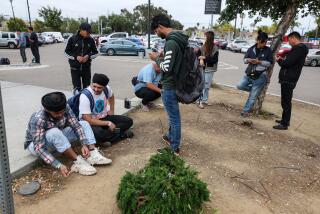State’s Launch of Caller ID Is Expected to Be Delayed Again
The long-delayed California debut of caller ID, a controversial new phone service that allows people receiving a call to see the caller’s phone number, is expected to be delayed again.
The California Public Utilities Commission on Wednesday voted unanimously to postpone by a month the June 1 start-up date for offering caller ID in California, after Pacific Bell said it was having trouble handling a flood of customer responses to a consumer education campaign on the new service.
However, for the delay to become official, the Federal Communications Commission must grant Pacific Bell a one-month extension on the agency’s requirement that phone companies nationwide, as of June 1, begin cooperating with each other in providing phone numbers for caller ID systems. San Francisco-based Pacific Bell filed a request for such an extension earlier this week, and it is expected to be approved.
Because about 40% of Californians have unlisted phone numbers, consumer activists and Pacific Bell executives estimate that 3 million or more of Pacific Bell’s 10 million customers have asked for their phone numbers not to be displayed on caller ID systems.
Although caller ID is now available in every other state, actual use is still relatively low in most regions. To see a caller’s phone number, a customer must pay $50 or more for a display device and a service charge every month.
Pac Bell is planning to charge $6.50 for the service and GTE will price it between $7 and $10.
Consumer activists note that if a large proportion of California residents decline to let their phone numbers be shown, the utility of the service in the state would be sharply reduced. Such a trend could also influence consumer decisions in other states, effectively sabotaging the service.
“California is a bellwether for this issue, like other issues,” said Evan Hendricks, editor of Privacy Times, a Washington-based newsletter. “Californians registered their desire for privacy by choosing unlisted numbers and they are sophisticated enough to understand that caller ID is designed to strip them of that choice.”
The California PUC originally voted to block consumer numbers from being released unless consumers took specific action to unblock their lines. The FCC overruled that decision last year.
The U.S. Supreme Court earlier this week declined to hear a PUC lawsuit challenging the constitutionality of the FCC decision.
But the PUC did require California phone companies, primarily Pacific Bell and GTE, to engage in an aggressive public education program asking customers to choose between completely blocking their phone lines or only selectively blocking the lines for specific calls. In the absence of a choice, their lines would be blocked only if they punched in a code before making a call.
Pacific Bell executives said Wednesday that even if the start of caller ID is delayed, consumers should still send in their choice forms promptly.
Pacific Bell has already received 6 million responses. The company would not say how many of those respondents asked to have their lines completely blocked, citing competitive concerns. But executives acknowledge, based on the large proportion of unlisted numbers in California, that it is high.
“It just shows that when you provide education, people’s choices will be different” from the court’s and the FCC’s, said Nettie Hoge, executive director of Toward Utility Rate Normalization, a consumer group.
Still, company executives evidently hope to change public perception.
“There are a lot of customers who are interested in caller ID even if they want their own numbers blocked,” said Marilyn Solis, director of new product development at Pacific Bell. If people with blocked lines find their phone calls aren’t getting answered because others mistake them for telemarketers, Solis said, more customers could choose to unblock their lines.
More to Read
Inside the business of entertainment
The Wide Shot brings you news, analysis and insights on everything from streaming wars to production — and what it all means for the future.
You may occasionally receive promotional content from the Los Angeles Times.










